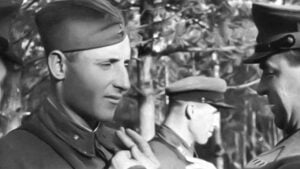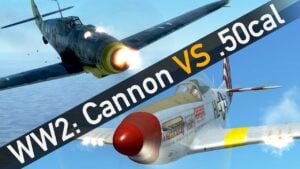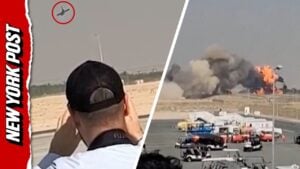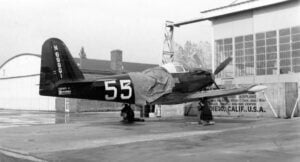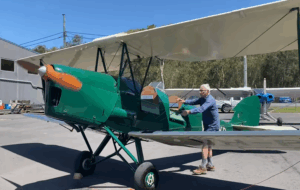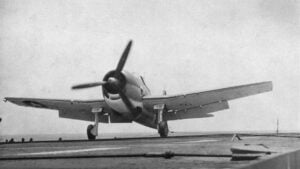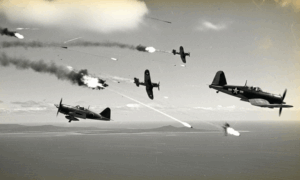The One Thing You Never Wanted to See on an American Plane
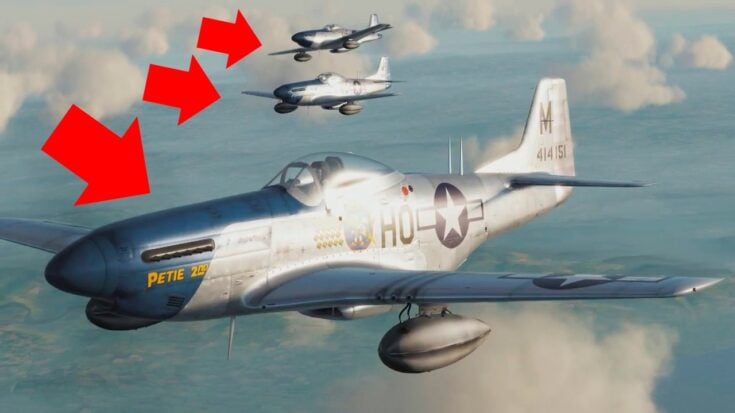
YouTube / Dark Skies
Lieutenant Colonel John C. Meyer’s P-51 Mustang thundered down the icy runway at Y-29 airfield in Belgium. It was supposed to be a routine patrol—just another cold morning in late-war Europe. Twelve fighters from the 352nd Fighter Group launched, their distinctive blue noses stark against the bleak winter sky.
But as Meyer lifted off, flak burst near the edge of the field. Confused, he radioed the tower—only to spot nearly 50 German fighters swarming in from the horizon. It was a surprise Luftwaffe attack, part of Operation Bodenplatte, intended to wipe out Allied aircraft on the ground.
Caught off guard but not unprepared, Meyer banked hard and opened fire—downing an Fw 190 before his landing gear even retracted. One by one, the rest of the Mustangs scrambled into the sky. The Germans had no idea they were flying straight into the teeth of the Blue-Nosed Bastards of Bodney.
The Early Days
The 352nd Fighter Group was born out of urgency. After the U.S. entered World War II in December 1941, military leaders knew they needed to rapidly expand the Army Air Forces.
Initially composed of the 21st, 34th, and 328th Fighter Squadrons, the unit had to make early changes. It turned out that both the 21st and 34th designations were already held by squadrons whose men had become POWs in the Philippines—so those were renamed the 486th and 487th, forming the core of the 352nd as it would fight through the war.
Most of the pilots had little to no flight experience and were quickly pushed through an intensive training program. They began their combat education in the burly Republic P-47 Thunderbolt, nicknamed the “Jug” for its juggernaut-like size and power. While it wasn’t the prettiest bird in the sky, pilots learned to appreciate its durability and firepower.
As training progressed, the green recruits began to gel into a skilled fighting force. They drilled on formation flying, gunnery, and tactics—skills they’d need very soon over Nazi-occupied Europe.
Learning the Hard Way
By September 1943, the 352nd was deployed to England and deemed ready for combat. But the P-47’s limited range meant that American fighters could only escort bombers partway into German territory. Once the Thunderbolts turned back, B-17s and B-24s were left to fend for themselves in the deadliest part of their mission.
Still, the 352nd adapted. On January 29, 1944, they participated in a large engagement that proved the P-47, when used correctly, could intercept and defeat German fighters effectively. That day, U.S. pilots claimed 47 German aircraft, with the 352nd contributing and gaining valuable experience, though not without cost—they lost 14 aircraft.
But everything changed when the P-51 Mustang arrived.
Carving a New Identity
When the 352nd received the long-range North American P-51 Mustang, it was a game-changer. Suddenly, they could escort bombers all the way to Berlin and back. Fast, agile, and with excellent high-altitude performance, the Mustang became every fighter pilot’s dream.
To mark this new chapter, the group adopted a bold new identity. They painted their Mustangs’ noses a distinctive blue, making them instantly recognizable in the sky. With their aggressive tactics and growing kill counts, they soon earned the name that stuck: “The Blue-Nosed Bastards of Bodney.”
Based out of Bodney, Norfolk from July 1943 to November 1945, they carved out a reputation as one of the deadliest units in the skies over Europe.
Legacy in the Skies
One of the unit’s most celebrated moments came on January 1, 1945, during the massive Luftwaffe attack on Allied airfields. The 487th Fighter Squadron stood its ground—and took to the skies—with incredible ferocity, shooting down 23 enemy aircraft in a single mission. It was the only individual squadron in the Eighth Air Force to be awarded a Distinguished Unit Citation, an honor typically reserved for full groups.
From green recruits in Thunderbolts to aces in blue-nosed Mustangs, the 352nd Fighter Group proved that skill, courage, and teamwork could overcome the odds—and turn the tide of a war.














